|
|
Post by creature386 on Nov 20, 2013 2:49:57 GMT 5
|
|
|
|
Post by Infinity Blade on Jan 22, 2015 2:04:57 GMT 5
Here are a couple pictures that I like ( edit 01/16/2019: yes, I know they, and the OP picture, are now not completely accurate). 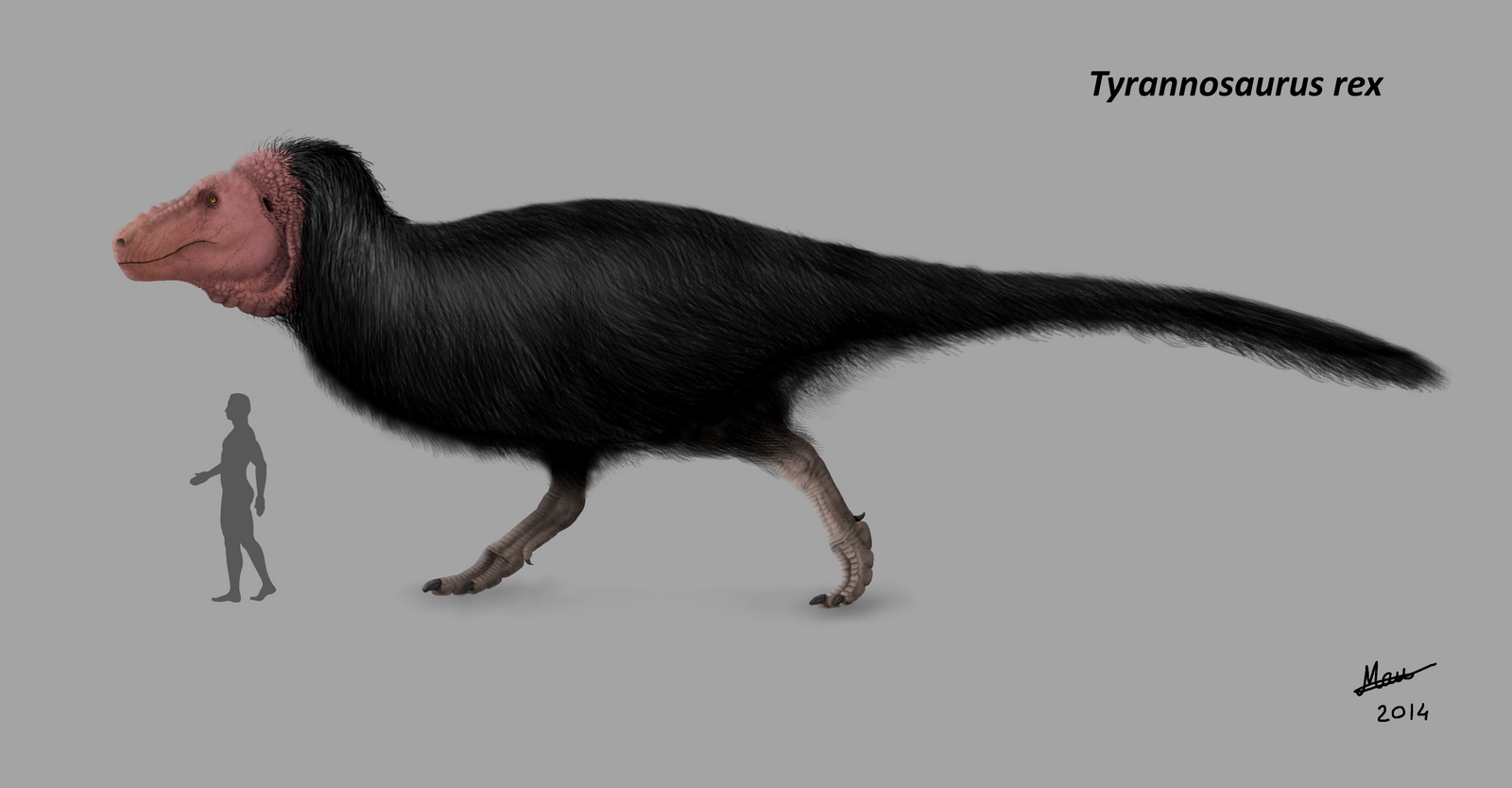 © @ MoriceMonkey93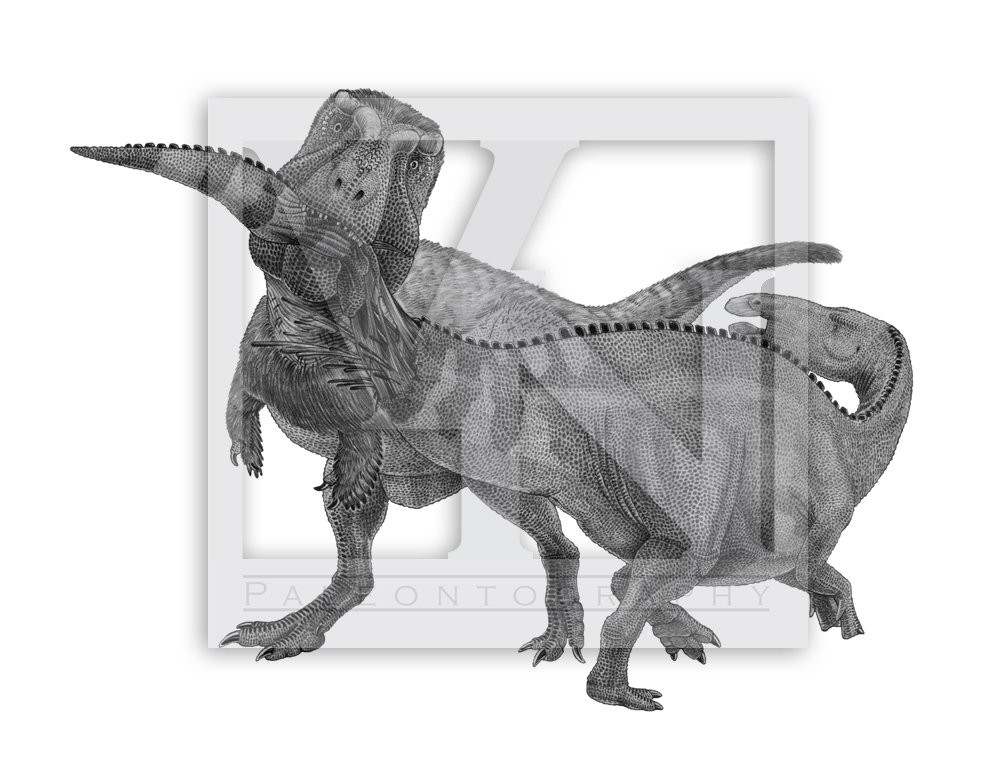 © @ T-PEKCSomething to note regarding healed hadrosaur tails bitten by Tyrannosaurus: DePalma et al. (2013) |
|
|
|
Post by Infinity Blade on Jan 22, 2015 6:35:25 GMT 5
Verdugo posted this on Carnivora, the source being Tyrannosaurus rex-The Tyrant King. So I thought why not post it here? 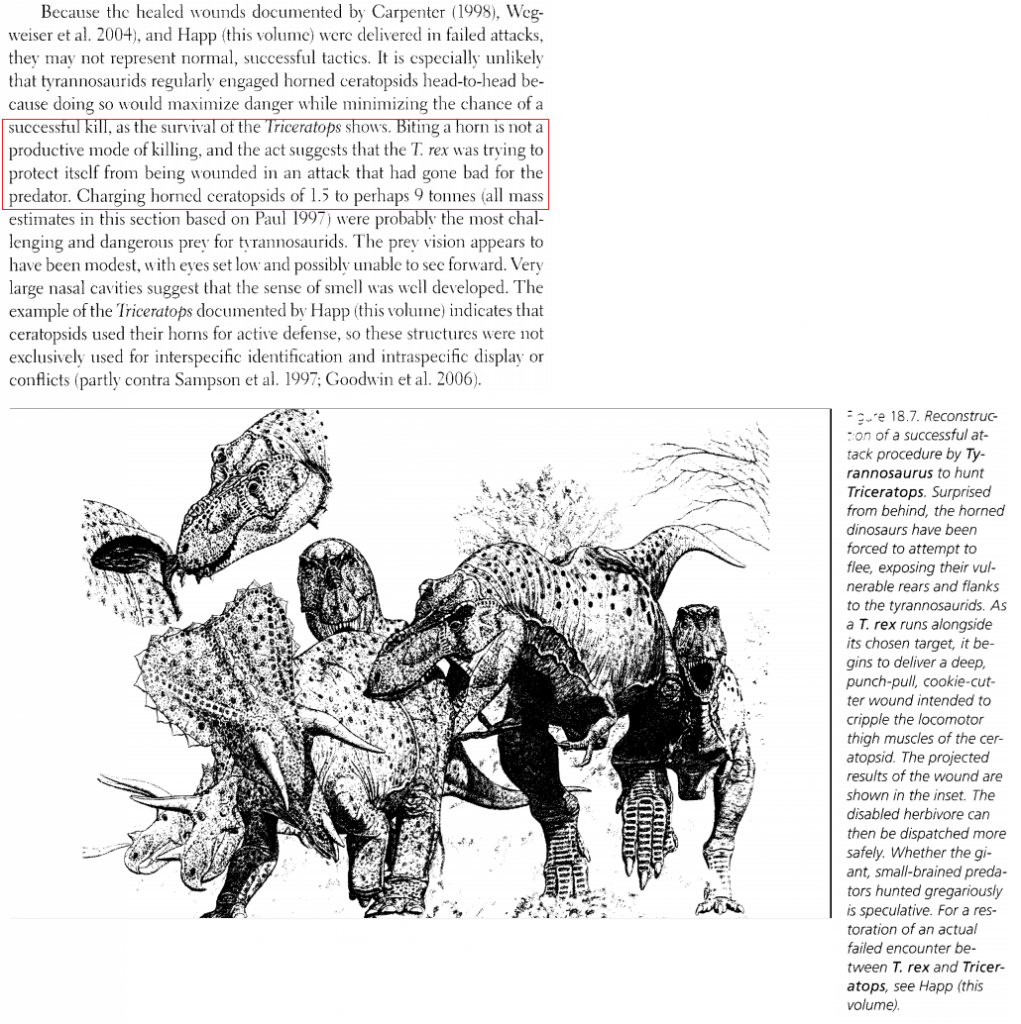 |
|
|
|
Post by Supercommunist on Jan 24, 2015 10:31:17 GMT 5
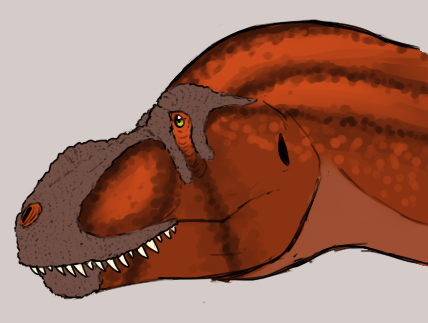 Fossil evidence indicates that tyrannosaur snouts were heavily abused in intraspecfic conflicts, how likely do you think it would be for tyrannosaurs to have evolved some form of snout protection like the image above? |
|
|
|
Post by Supercommunist on Jan 24, 2015 10:34:24 GMT 5
 ^Another image with a tyrannosaurus with some sort of keratin snout armor. |
|
|
|
Post by Infinity Blade on Feb 16, 2015 6:56:39 GMT 5
Re. the sense of balance in this dinosaur. I have posted a study before showing that bipedal dinosaurs tended to have relatively larger semicircular ear canals than did quadrupedal dinosaurs (the semicircular ear canals help govern the sense of balance in animals). Here it is below. Reference: Georgi et al. (2013)So, bipedal dinosaurs made up for their less stable bipedal posture with relatively larger semicircular ear canals. But that's not all regarding Tyrannosaurus' semicircular ear canals and sense of balance (though I'm sure the following would have applied to other predatory dinosaurs; certainly T. rex's small coelurosaurian ancestors). See what Witmer & Ridgely have said about them below. Reference: Witmer & Ridgely (2009)In other words, tyrannosaurs had semicircular ear canal dimensions consistent with an agile and active lifestyle. However, the extent of the elongation of the lateral canal (and rostral canal) in tyrannosaurs cannot be explained by bipedality alone, or to put it another way, the semicircular ear canals were more elongated than they needed to be. This might suggest that, at least for animals of their size, tyrannosaurids were rather agile predators able to retain a stable gaze when moving. |
|
Deleted
Deleted Member
Posts: 0
|
Post by Deleted on Jun 11, 2015 0:05:58 GMT 5
|
|
|
|
Post by spinodontosaurus on Jun 11, 2015 2:32:01 GMT 5
I don't have any of the literature describing the specimens above, bar Sue, but some of those measurements seem suspicious. Namely CM 9380 having it's femur listed at 120 cm instead of 127 cm, BHI 3033 at 131 cm instead of 128 cm, and FMNH PR2081 at 134 cm instead of 131 cm. MOR 1125 too.
Does anyone know what's up with that?
|
|
|
|
Post by theropod on Jun 11, 2015 2:55:54 GMT 5
I’ve compiled this table by adding age data from Erickson et al. 2006 where they were available (sp=specimen, fl=femur lenght(mm), fc=femur circumference (mm), age=ontogenetic age in years):
sp fl fc age
1 CM 9380 1200 545 22
2 MOR 1128 1260 580 22
3 MOR 1125 1150 510 19
4 MOR 555 1275 514 22
5 MOR 98O 1232 483 21
6 FMNH PR 2081 1340 580 28
7 BHI 3033 1310 500 18
8 BHI 6232 1180 527 NA
9 BHI 6233 1110 515 NA
10 BHI 6230 1190 494 18
11 BHI 6242 1180 512 NA
12 RTMP 81.12.1 1200 560 22
13 RTMP 81.6.1 1210 470 18
14 LL12823 1200 467 NA
15 Samson 1295 560 23
16 USNM 6183 990 425 17It seems that except for one unusually small specimen (USNM 6183, which is either a young adult or old subadult), all of those in which the age is known represent adult specimens, and the others are within their size range or closer to it. Based on this dataset for mean femur length and circumference in the above are 1208mm (0.901×FMNH PR 2081) and and 515mm (0.888×FMNH PR 2081). Excluding the 17-year old USNM 6183, we get 1222mm and 521mm respectively, or 91.2% and 89.9% of the same measurement as given for FMNH PR 2081. For some visual demonstration:   I get what blaze means. To me this doesn’t look like two distinct "morphs", much rather individual variation as expected at any size, and a slight gap explained by the small sample size. ---References:Erickson, Gregory M.; Currie, Philip J.; Inouye, Brian D.; Winn, Alice A. (2006): Tyrannosaur Life Tables: An Example of Nonavian Dinosaur Population Biology. Science, Vol. 313 (5784) pp. 213-217 Larson, Peter (2008): Variation and Sexual Dimorphism in Tyrannosaurus rex. In: Larson, Peter; Carpenter, Kenneth: Tyrannosaurus rex the Tyrant King. Bloomington pp. 103-128 |
|
|
|
Post by creature386 on Aug 26, 2015 21:48:40 GMT 5
We've got another fighter rex:
|
|
|
|
Post by Infinity Blade on Aug 27, 2015 0:01:51 GMT 5
Oh how I love SVP; it's always full of surprises and amazing findings. A SUBADULT TYRANNOSAURUS REX AND ITS BEARING ON THE NANOTYRANNUS HYPOTHESISCARR, Thomas D., Carthage College, Kenosha, WI, United States of America, 53140; HENDERSON, Michael, Northern Illinois University, DeKalb, IL, United States of America; ERICKSON, Gregory, Florida State University, Tallahassee, FL, United States of America; PETERSON, Joe, University of Wisconsin - Oshkosh, Oshkosh, WI, United States of America; WILLIAMS, Scott, Burpee Museum of Natural History, Rockford, IL, United States of America; CURRIE, Philip, University of Alberta, Edmonton, AB, Canada; SCHERER, Reed, Northern Illinois University, DeKalb, IL, United States of America; HARRISON, Bill, Northern Illinois University, DeKalb, IL, United States of America " In 2002, a rare, surprisingly complete, and partially articulated skull and skeleton of a subadult tyrannosaurid (BMRP 2002.4.1) was collected by the Burpee Museum (Rockford, IL) from the Hell Creek Formation in southeastern Montana. We refer the skeleton to Tyrannosaurus rex based on the presence of several autapomorphies of that taxon: a long caudolateral process of the nasal, extensive contact between the antorbital fossa and the nasal, and a narrow snout and wide temporal region that orient the orbital fenestrae forward. The ~20 foot (6 m) -long skeleton gives an unprecedented view of an early growth stage of a dinosaur whose fossil record is dominated by adult skeletons. Evidence for its subadult growth stage comes from several lines of evidence, including size, relative development of hundreds of osteological features, and bone histology, which gives a chronological age of ~11 years. Based on a cladistic analysis of ontogenetic characters, BMRP 2002.4.1 was found to occupy a new growth stage, between a smaller juvenile (CMNH 7541) and a larger subadult (LACM 23845). With the addition of the new specimen, the early part of the growth series is more completely understood. In this context, BMRP 2002.4.1 is important in testing recent claims of the validity of Nanotyrannus lancensis; the specimen is similar in many ways to the holotype of N. lancensis (CMNH 7541), which has been critically assessed and identified as a juvenile T. rex. The sequential position of these specimens in the growth series suggests that the similarities are the result of their relative immaturity, not autapomorphies of a novel taxon. In a larger context, the growth changes seen early in T. rex ontogeny are also seen in the growth of all derived tyrannosauroids (Bistahieversor + Tyrannosauridae ). This shows that ontogeny in this clade is highly conserved, specifically the gross differences between subadult and adult specimens. Among other changes, our BMRP 2002.4.1 data suggest that in T. rex , maxillary and dentary tooth counts increase early in ontogeny before decreasing through adulthood; the lacrimal has a prominent horn at this growth stage, which is later lost to inflation in adults; and caudal neurocentral suture closure follows an anteriorward sequence. The specimen reveals a distinct feature of T. rex , where the humerus of BMRP 2002.4.1 is relatively long in contrast to subadult tyrannosaurids of similar growth stage. Finally, despite the discovery of this important specimen, a substantial gap in the growth series is seen between the gracile subadults and the robust adults." vertpaleo.org/PDFS/39/39ad8cfa-19a3-4d99-a9fb-0dee66022922.pdf |
|
|
|
Post by jhg on Jul 15, 2016 21:23:31 GMT 5
It looks like a giant cassowary! |
|
|
|
Post by Ceratodromeus on Aug 19, 2016 9:19:27 GMT 5
Rare Tyrannosaurus rex skull arrives at Seattle museum SEATTLE (AP) — Paleontologists with Seattle’s Burke Museum have unearthed the bones of a Tyrannosaurus rex that lived more than 66 million years ago, including a rare nearly complete 4-foot long skull. The remarkable discovery includes the dinosaur’s vertebrae, ribs, hips and lower jaw bones, and represents about 20 percent of the meat-eating predator. Several dozen scientists, volunteers, students and others worked over the summer to excavate the bones in the Hell Creek Formation in Montana, a site well known for fossil finds. The team later encased the massive skull in a protective plaster cast, lifted the 2,500-pound load onto a flatbed truck with the help of local Montana ranchers and drove it to Seattle. The skull was unloaded at the Burke Museum Thursday. The plaster-covered skull will be on display to the public for several weeks starting Saturday. Over the next year, paleontologists will painstakingly work on removing the rock around the skull. Scientists estimate the dinosaur is 85 percent the size of the largest T. rex discovered and, based on the size of its skull, lived about 15 years. They believe this T. rex roamed the earth in the late Cretaceous period. There are only 14 other nearly complete T. rex skulls that have been found, the museum said. “We think the Tufts-Love Rex is going to be an iconic specimen for the Burke Museum and the state of Washington and will be a must-see for dinosaur researchers as well,” Gregory Wilson, a University of Washington biology professor and adjunct curator of vertebrate paleontology at the Burke Museum, said in a statement. He led the expedition team. The T. rex is named after two museum paleontology volunteers, Jason Love and Luke Tufts, who were combing for fossils when they came across large fossilized vertebrae sticking out of a rocky hillside last summer. The two were with a team collecting fossils as part of the Hell Creek Project, currently led by Wilson and started by Jack Horner, who discovered the world’s first dinosaur embryos, and Nathan Myhrvold, former Microsoft chief technology officer who is a Burke Museum research associate. The team knew the fossils belonged to a meat-eating dinosaur because of the large size and appearance of the bones, but they weren’t sure whether it was a T. rex. They didn’t have the chance to excavate further until this summer when they returned to the site. Over the course of a month, Burke paleontologists and others used tools such as jackhammers, axes and shovels to dig up the bones. They first removed about 20 tons of rock and then dug further to uncover pelvic bones and other parts. More digging led to the most amazing find: the right side of the T. rex skull, including snout and teeth. Scientists think the other half of the skull is there as well. They plan to return to the site next year to search for that and other dinosaur parts. Horner, a Burke Museum research associate who built a vast collection of dinosaur specimens while at the Museum of the Rockies in Bozeman, Montana, said in the statement that the discovery was “one of the most significant specimens yet found.” www.johnsoncitypress.com/News/2016/08/18/Rare-Tyrannosaurus-rex-skull-arrives-at-Seattle-museum.html?ci=stream&lp=1&p=1
|
|
Deleted
Deleted Member
Posts: 0
|
Post by Deleted on Jul 4, 2017 8:54:40 GMT 5
|
|
|
|
Post by Infinity Blade on Jul 5, 2018 0:50:16 GMT 5
Well, look how well I've kept my promise on editing this profile! /sarcasm Although I haven't posted a new profile in a while, I will contribute a bit to this one. Here's a recent skeletal and muscular reconstruction by RJ Palmer (he has updated the look of the Tyrannosaurus for the Saurian game).  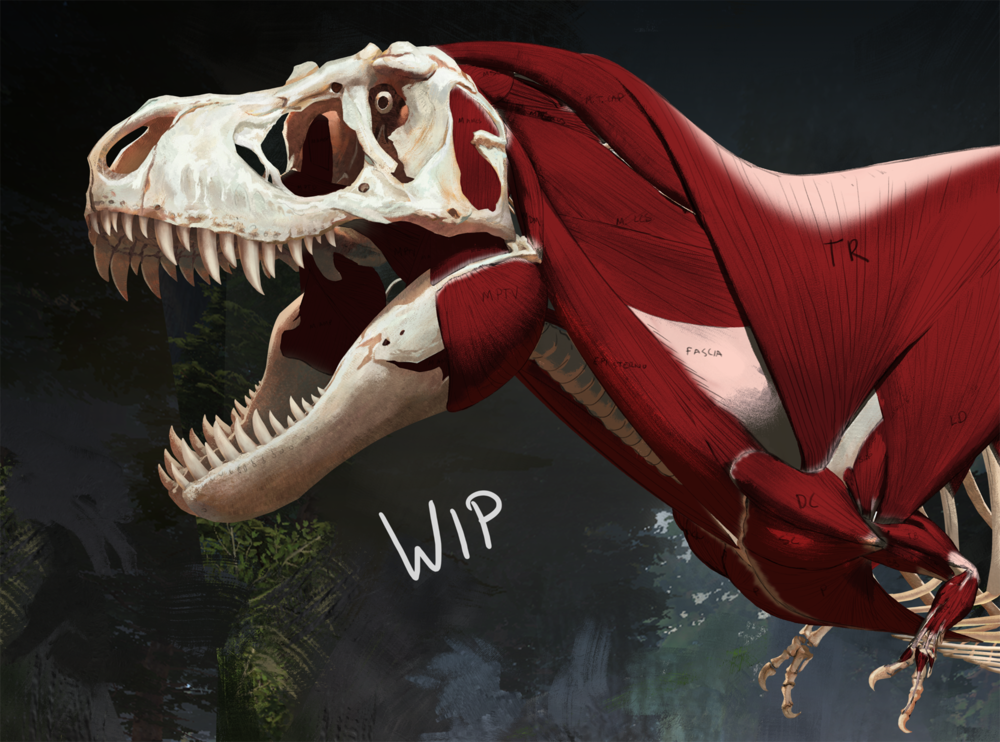 |
|